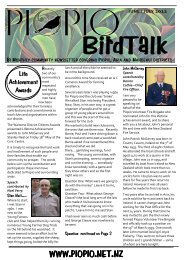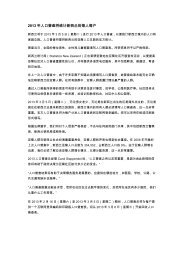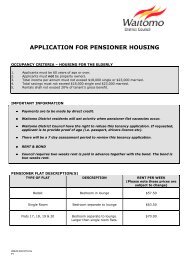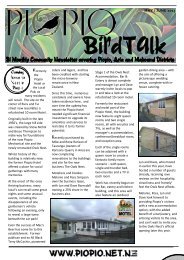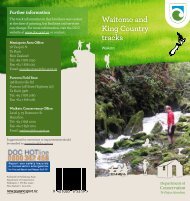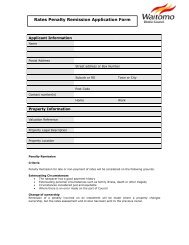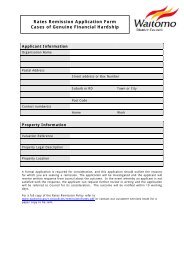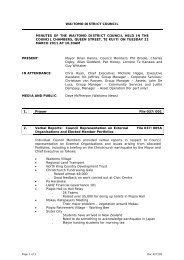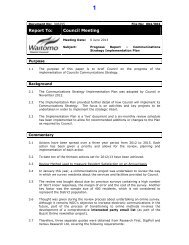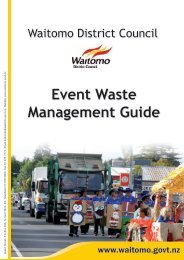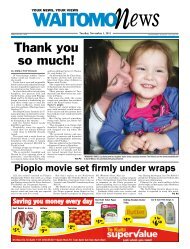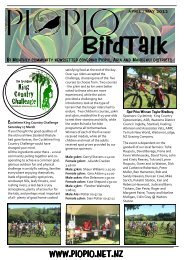JOINT MANAGEMENT AGREEMENT - Waitomo District Council
JOINT MANAGEMENT AGREEMENT - Waitomo District Council
JOINT MANAGEMENT AGREEMENT - Waitomo District Council
Create successful ePaper yourself
Turn your PDF publications into a flip-book with our unique Google optimized e-Paper software.
<strong>JOINT</strong> MANAGEment <strong>AGREEMENT</strong>Maniapoto Māori Trust BoardOtorohanga <strong>District</strong> <strong>Council</strong>Waikato <strong>District</strong> <strong>Council</strong>Waikato Regional <strong>Council</strong>Waipa <strong>District</strong> <strong>Council</strong><strong>Waitomo</strong> <strong>District</strong> <strong>Council</strong>
Cover photography credit: Guy Russell, Waikato Regional <strong>Council</strong>.
<strong>JOINT</strong> <strong>MANAGEMENT</strong> <strong>AGREEMENT</strong>Dated: 3 April 2013PARTIES:1. Maniapoto Māori Trust Board (MMTB), a trust established under the Maniapoto Māori Trust Board Act1988 or a separate trust or other body that may be established to carry out functions and duties, andexercise powers under this Agreement and the Waipa River Act.2. Otorohanga <strong>District</strong> <strong>Council</strong>, a <strong>District</strong> <strong>Council</strong> duly constituted by the Local Government Act 2002.3. Waikato <strong>District</strong> <strong>Council</strong>, a <strong>District</strong> <strong>Council</strong> duly constituted by the Local Government Act 2002.4. Waikato Regional <strong>Council</strong> (the Regional <strong>Council</strong>), a Regional <strong>Council</strong> duly constituted by the LocalGovernment Act 2002.5. Waipa <strong>District</strong> <strong>Council</strong>, a <strong>District</strong> <strong>Council</strong> duly constituted by the Local Government Act 2002.6. <strong>Waitomo</strong> <strong>District</strong> <strong>Council</strong>, a <strong>District</strong> <strong>Council</strong> duly constituted by the Local Government Act 2002.For the purposes of this joint management agreement all councils will be collectively known as LocalAuthorities.Where the Waikato Regional <strong>Council</strong> and the Territorial Authorities differ on functions, powers and duties adistinction will be made.Each one is a Party and together they are referred to as the Parties.BACKGROUNDA. On 27 September 2010, Maniapoto, through the Maniapoto Māori Trust Board (the MMTB) and the Crownsigned a Deed in Relation to Co-Governance and Co-Management of the Waipa River (the Maniapoto Deed)which was directed to deliver a new era of co-management over the Waipa River with an overarchingpurpose of restoring and maintaining the quality and integrity of the waters that flow into and form partof the Waipa River for present and future generations and the care and protection of the mana tuku iho oWaiwaia.B. The Nga Wai o Maniapoto (Waipa River) Act 2012 (the Waipa River Act) was enacted to give effect to theManiapoto Deed. A joint management agreement is to be entered into under the Waipa River Act betweenthe Local Authorities and the MMTB.C. The Local Authorities and the MMTB have agreed to enter into one collective agreement for all of its jointmanagement arrangements. This joint management agreement (this Agreement) is therefore entered intopursuant to the Waipa River Act and the wishes of the Parties.D. The MMTB recognises that some of the Local Authorities may or will have Agreements with other iwi, orhave relationships with other tāngata whenua groups of varying degrees of formality. MMTB is supportiveof these arrangements insofar as they are consistent with this Agreement.E. Te Awa o Waipa is a taonga to Maniapoto. Maniapoto have a deep felt obligation and desire to restore,maintain and protect all of the waters that flow and/or fall within the Maniapoto rohe (Ngā Wai o Maniapoto),whether the waters are above, on or underground. Te Mana o Te Wai (The quality and integrity of thewaters) is paramount. The obligation includes the waters that flow into and form part of the Waipa River.Page 1 of 14
The relationship between Maniapoto and the Waipa River is historic, intellectual, physical and spiritual.Historically, Te Mana o Te Wai was such that it provided all manner of sustenance to Maniapoto includingphysical and spiritual nourishment that has, over generations, maintained the quality and integrity ofManiapoto marae, whānau, hapū and iwi. To Maniapoto the Waipa River has mana and in turn represents themana of Maniapoto. The Waipa River is a single indivisible entity that flows from Pekepeke to its confluencewith the Waikato River and includes its waters, banks, bed (and all minerals under it) and its streams,waterways, tributaries, lakes, fisheries, vegetation, floodplains, wetlands, islands, springs, geothermalsprings, water column, airspace and substratum as well as its metaphysical elements with its own mauri.MATTERS AGREED1. Purpose1.1 The purpose of this Agreement is to provide for the Local Authorities and MMTB to work together in carryingout the functions, duties and powers provided for in and to give effect to the Waipa River Act.2. Scope of Agreement2.1 This Agreement:(a)(b)Covers matters relating to the Waipa River and activities within its catchment affecting the WaipaRiver as depicted in Schedule One;Covers matters relating to the exercise of shared functions, duties and powers in relation to:(i)(ii)(iii)Monitoring and enforcement activities as provided for in section 21 of the Waipa River Act;Preparing, reviewing, changing or varying a RMA Planning Document, as provided for insection 22 of the Waipa River Act; andConsidering applications under Part 6 of the RMA in relation to resource consents as providedfor in section 23 of the Waipa River Act.(c)May cover additional duties, functions or powers as agreed between the MMTB and the LocalAuthorities, whether collectively or individually.3. Term3.1 The Parties agree and acknowledge that under the Waipa River Act this Agreement will commence on theCommencement Date and will remain in force for perpetuity.4 Principles4.1 The Parties acknowledge and agree that in working together they will:(a)Give appropriate weight to the relevant matters and documents provided for under the Waipa RiverAct, including:(i)(ii)(iii)(iv)(v)the overarching purpose of the Waipa River Act, being to restore and maintain the qualityand integrity of the waters that flow into and form part of the Waipa River for present andfuture generations and the care and protection of the mana tuku iho o Waiwaia;Te Ture Whaimana;The Waipa River Integrated River Management Plan;The Maniapoto Objectives for the Waipa River as outlined in Schedule Two; andThe Maniapoto Iwi Environmental Management Plan;Page 2 of 14
(b)(c)(d)(e)(f)(g)(h)(i)(j)(k)(l)(m)Respect the mana of Maniapoto;Act in a manner consistent with the principles of Te Tiriti o Waitangi / The Treaty of Waitangi; andRecognise the statutory functions, powers and duties of the Local Authorities under legislation.Commit to work together in good faith and a spirit of co-operation;Commit to open, honest and transparent communication;Recognise and acknowledge that the Parties will benefit from working together by sharing theirrespective vision, knowledge and expertise;Ensure early engagement and a “no surprises” approach;Recognise that the relationship between the Parties will evolve;Promote the principle of and efficient participation in co-management;Recognise that co-management and this Agreement operates within statutory frameworks that mustbe complied with;Commit to meeting statutory timeframes and minimising delays and costs associated with thosestatutory frameworks; andUse their best endeavours to ensure that the purpose of this Agreement is achieved in an enduringmanner.5. Monitoring and Enforcement5.1 This section applies to monitoring and enforcement relating to the Waipa River and activities within itscatchment affecting the Waipa River.5.2 The Parties acknowledge that the Regional <strong>Council</strong> has long-standing monitoring networks for both nationaland regional state of the environment reporting and trend analysis. The Parties will endeavour to ensurecompatibility between any new monitoring and any Local Authorities’ existing monitoring obligations.5.3 The Parties will meet, either collectively or separately, at an operational level no less than twice a year to:(a)Discuss and agree the priorities, the methods and the extent of monitoring; and any monitoringguidelines or frameworks required, and to discuss appropriate responses to address the outcomes ofthe monitoring of those matters set out in section 35(2)(a) to (e) of the RMA. Those matters being:(i)(ii)(iii)(iv)(v)The state of the environment of its region or district to the extent that is appropriate toenable the Local Authority to effectively carry out its functions under the RMA;Efficiency and effectiveness of policies, rules or other methods in the RMA PlanningDocuments;Exercise of any functions, powers or duties delegated or transferred by the Local Authorities;Exercise of resource consents that have effect in the Local Authorities’ region or districts; andIn the case of the Regional <strong>Council</strong>, the exercise of a protected customary right in theWaikato Regional <strong>Council</strong> boundary including any controls imposed on the exercise of thatright under the Marine and Coastal Area (Takutai Moana) Act 2011.(b)(c)Discuss reciprocal educational and training needs;Discuss the potential for the MMTB to participate in the monitoring of those matters set out inclause 5.3(a) above;Page 3 of 14
(d)(e)Discuss the role of the MMTB with the Local Authorities of compiling and making available to thepublic a review of the results of its monitoring of the efficiency and effectiveness of policies rules orother methods in its RMA Planning Documents;Discuss appropriate responses to address the outcomes of the monitoring of those matters set outin clause 5.3(a) above, including:(i)(ii)The potential for review of RMA Planning Documents; andEnforcement under the RMA, including criteria for the commencement of prosecutions,applications for enforcement orders, the service of abatement notices, and the service ofinfringement notices.(f)(g)Discuss the potential for person(s) nominated by the MMTB to participate, at the direction of theLocal Authorities, in enforcement action under the RMA; andDiscuss and agree the role of the MMTB in the five yearly review provided for in section 35(2A) of theRMA.5.4 Subject to any obligations of privacy or confidentiality, the Local Authorities will report to the MMTBon enforcement action they have undertaken. Subject to clause 5.3(b) above, this will be in a mannerconsistent with internal Local Authorities reporting.5.5 Each Party bears its own costs in complying with this Section.6. RMA Planning Documents6.1 RMA Planning Documents Scope6.1.1 This section applies to preparing, reviewing, changing, or varying a RMA planning document to the extent towhich those processes are related to Te Ture Whaimana, as it relates to the area noted in 2.1(a ).6.2 Early Engagement6.2.1 If, as a result of emerging issues, any one of the Local Authorities is prompted to consider the preparation,review, change or variation of an RMA Planning document (including requests for private plan changes) keypersonnel from the Local Authority concerned will as soon as reasonably practicable, contact key personnelfrom the MMTB for initial discussions on the issues and whether there is a need to participate in theprocesses by convening a Joint Working Party (JWP).6.3 Joint Working Party6.3.1 If it is agreed that a JWP should be convened, the MMTB and the Local Authority considering the preparation,review, change or variation of an RMA Planning document will:(a)(b)(c)(d)(e)Meet at an appropriate time to convene;Determine the makeup of the JWP;Discuss whether to include other Parties of the Agreement to the JWP;Confirm how all Parties will work together and how they will resolve disputes; andRecommend to the Local Authority considering the preparation, review, change or variation of anRMA Planning document:Page 4 of 14
(i)(ii)The process to be adopted; andThe general form and content of any document to be drafted for the purposes of consultation ornotification under clause 5 of Schedule 1 of the RMA.6.3.2 When working together the JWP will adopt the principles as outlined in clause 4 of this Agreement.6.3.3 Confirmation of the members of the JWP and the process to be followed is to be either by letter or email toall Parties to the Agreement to confirm members and commitment to the process.6.3.4 A JWP recommendation to a particular Local Authority is considered a formal recommendation prepared bythe JWP to that Local Authority which is preparing to initiate a formal process to prepare, review, change orvary an RMA Planning Document.6.3.5 The recommendation will confirm the process that will be adopted and the general form and content of thedraft RMA Planning Document.6.3.6 Each Party bears its own costs of complying with this section.6.4 Requests for Private Plan Changes6.4.1 If a request is made under Clause 21 of Schedule 1 of the RMA, and relates to the Waipa River or its catchment,the Local Authority concerned will provide a copy of the request to key personnel from the MMTB as soonas practicable.6.4.2 The MMTB will advise the Local Authority concerned whether it wishes to participate in the process, andshould the MMTB wish to participate, the Local Authority concerned will convene a meeting between thetwo parties to discuss the statutory and internal processes for considering a request.6.4.3 Should the MMTB confirm they wish to participate in considering a request; a JWP will be convened todevelop and agree upon a process for the MMTB to be involved.6.5 Joint Recommendations (Final)6.5.1 A joint final recommendation is a formal recommendation prepared by the JWP to the MMTB and thatparticular Local Authority which is preparing to initiate a formal process to prepare, review, change or varya RMA Planning Document. The form of the recommendation is in writing, signed by all the JWP members,or provided by email, copied in to all the JWP members.6.5.2 There are two mandatory joint final recommendations:(a)(b)Whether to commence a review, change or variation to a RMA Planning Document; andThe content of a RMA Planning Document to be notified.6.5.3 It is agreed that the approved formal recommendations reported to the MMTB and particular Local Authorityconcerned will be identical in wording and intent.6.6 Decision-Making Opportunities6.6.1 It is agreed that prior to the development of a final joint recommendation on the content of the draft RMAPlanning Document to be notified, the JWP will discuss the potential for the MMTB to participate in makingdecisions on the draft RMA Planning Document under clause 10 of Schedule 1 of the RMA .6.6.2 The report containing the final joint recommendation will incorporate the discussions and note the agreedposition of the JWP for the participation of Maniapoto in decision-making.Page 5 of 14
7.2.8 The criteria developed and agreed under clause 7.2.7(a)(b)Are additional to, and do not derogate from, the criteria that the Local Authorities must apply underthe RMA; andDo not impose a requirement on a Local Authority to change, cancel, or review consent conditions.7.2.9 Each Party bears its own costs for complying with this section.8. Dispute Resolution8.1 The Parties agree and acknowledge that for this Agreement to be effective the resolution of issues betweenthem must be addressed in a constructive, co-operative and timely manner that is consistent with theAgreement’s principles set out in clause 4.8.2 The dispute resolution process is:(a)(b)(c)(d)If the Parties cannot reach agreement or if one Party considers that there has been a breach of thisAgreement then that Party may give notice to the other Party or Parties that they are in dispute.As soon as practicable upon receipt of the notice, the Local Authority concerned will meet with theother Local Authorities and the MMTB’s representative(s) in good faith to resolve the issue.If the dispute has not been resolved within 20 Working Days of receipt of the notice, the ChiefExecutive Officer of each Local Authority and the Chief Executive of the MMTB will meet to work ingood faith to resolve the issue.If the dispute has still not been resolved within 30 Working Days of a meeting between the ChiefExecutive Officer of each Local Authority and the Chief Executive of the MMTB, and as a matter oflast resort, the respective Mayor/Chair (or nominee) or the governance forum will meet to work ingood faith to resolve the issue.9. Suspension9.1 A particular Local Authority or collectively the Local Authorities, and the MMTB may agree in writing tosuspend, in whole or part, the operations of this Agreement. In reaching this decision, the parties mustspecify the scope and duration of the suspension in writing. For the sake of clarity, in any suspension of theoperations of this Agreement, in whole or part, one of the parties to the suspension must be the MMTB.10. Waiver of Rights10.1 The MMTB may give written notice to the Local Authority as a collective or a particular Local Authority, thatit wishes to waive a right provided for in this Agreement.10.2 The MMTB must specify the extent and duration of the waiver in the notice.10.3 The MMTB may at any time revoke a notice of waiver by written notice to the Local Authorities, whetherindividually or as a collective.11. Review and Amendment11.1 The Parties agree that this Agreement is a living document which may be reviewed and amended ascircumstances require.11.2 The initial review of this Agreement will take place no later than two years from the Commencement Dateand biennially thereafter with all Parties.11.3 If the Parties, whether individually or collectively as a Local Authority with the MMTB, agree to amend thisAgreement then changes will be made by way of written variation to this Agreement.Page 7 of 14
11.4 The Local Authorities and the MMTB will provide written notice of the changes and a copy of the amendedAgreement to the Minister for the Environment.12 Exercise of Powers12.1 A Local Authority may carry out its functions or exercise its power on its own account and not in accordancewith this Agreement if:(a)(b)An emergency situation arises; orA statutory timeframe for the carrying out of the function or the exercise of the power is not able tobe complied with under this Agreement.12.2 As soon as practicable the Local Authority concerned will provide the MMTB with written notice of carryingout this function or exercise of power.13 Information Sharing13.1 The Parties recognise the benefit of mutual information exchange.13.2 The Local Authorities will make available to the MMTB all information held by the Local Authorities (subjectto the Local Government and Official Information and Meetings Act 1987) where that information isrequested by the MMTB for the purposes of assisting it to exercise its mana in respect of the Waipa Riverand enabling the MMTB to exercise its rights fully under this Agreement.13.3 The MMTB may make available to the Local Authorities, information where appropriate, and when requestedby a particular Local Authority, to enable the Local Authority to fulfil its statutory obligations and obligationsunder this Agreement.14 Communication14.1 The Local Authorities and the MMTB will establish and maintain effective and efficient communication witheach other on a continuing basis by:(a)(b)(c)The MMTB providing, and the Local Authorities maintaining, contact details for MMTB personnelresponsible for engagement under this Agreement;The Local Authorities providing, and the MMTB maintaining, contact details for Local Authoritypersonnel responsible for engagement under this Agreement; andIdentifying and educating staff who will be working closely with each other from each respectiveParty and informing them of the obligations under this Agreement.Page 8 of 14
15 Governance15.1 A co-governance forum will be established to be the guardian of this Agreement.15.2 The co-governance forum will be made up of equal numbers of representatives from the Local Authoritiesand the MMTB. For the avoidance of doubt and by way of example, if each of the five Local Authoritiesappoint one representative then the MMTB will appoint five representatives.15.3 There will be co-chairs presiding over the meetings; one will represent the MMTB and one will represent theLocal Authorities.15.4 The co-governance forum will meet at least annually or more frequently if the co-governance forumconsiders it necessary.15.5 The role of the co-governance forum is to keep this Agreement under review to determine whether theAgreement is being implemented to the satisfaction of all the Parties and in accordance with the principlesset out in clause 4.15.6 Staff members will attend the governance forum meetings for technical support.15.7 The Parties will appoint a senior staff member to be the key contact and to oversee the implementation ofthis Agreement.16 Other Matters16.1 The Parties acknowledge that section 28 of the Waipa River Act provides for the Local Authorities to extendthis Agreement to cover duties, functions or powers that are in addition to those specified in section 19 ofthe Waipa River Act.16.2 The Parties agree that they may enter into discussions to extend this Agreement to cover other matters aspart of the enduring relationship.16.3 By way of example only, other matters could include, but are not limited to:(a)(b)(c)(d)(e)Determining and implementing clean up priorities for the Waipa River;Research opportunities;Joint projects;Secondments and internships; andStaff education and awareness projects.16.4 The progression and timing of other matters will be subject to all Parties approval by their respectivecouncils and in case of the MMTB, its board.16.5 The Parties agree that they may, from time to time, collectively or individually, draft schedules to thisAgreement to assist with the effective implementation of this Agreement. For the sake of clarity, schedulesare to be appended only with the agreement of all the Parties through the appropriate delegated authority.Page 9 of 14
17 Definitions and Interpretation17.1 In this Agreement, unless the context requires otherwise terms defined in the Waipa River Act have thesame meaning in this Agreement, and shall prevail where there is any difference. In addition and for clarity:“Agreement” means this Joint Management Agreement between the Parties.“Commencement Date” means the date this Agreement is signed by all of the Parties.“Local Authority” means the Regional <strong>Council</strong> and the Territorial Authorities and is more fully defined inthe Waipa River Act.“Mana of Maniapoto” includes principles such as:i) respect for the mana of Waiwaia and recognition that Waiwaia is the mauri and waiora of the WaipaRiver;ii)iii)respect for the mana of Maniapoto and recognition of the significance of the Waipa River to themana of Maniapoto; andrecognition that Maniapoto have their own distinct relationship with the Waipa River and that thearea encompassing the Upper Waipa River is distinct and the particular characteristics of the UpperWaipa River and its place within the rohe and customs of Maniapoto must be respected.“Mana tuku iho o Waiwaia” means the ancestral authority and prestige handed down from generation togeneration in respect of Waiwaia. ”Waiwaia” refers to the essence and wellbeing of the Waipa River and,to Maniapoto, Waiwaia is the personification of the waters of the Waipa River, its ancient and enduringspiritual guardian.“Maniapoto” has the same meaning as set out in the Waipa River Act.“Maniapoto Iwi Environmental Management Plan” means the plan prepared by the MMTB and issued byit on 19 March 2007 and includes any amendments or replacements to the plan.“Maniapoto Objectives” means the current Maniapoto Objectives for the Waipa River as set out in theManiapoto Deed and the Waipa River Act and described in Schedule Two.“Regional Policy Statement” has the same meaning as set out in the RMA.“RMA Planning Document” has the same meaning as set out in the Waipa River Act.“RMA” means the Resource Management Act 1991.“Territorial Authority” has the same meaning as set out in the Local Government Act 2002.“Te Ture Whaimana” means the Te Ture Whaimana o te Awa o Waikato, The Vision and Strategy for theWaikato River and has the same meaning as set out in the Waipa River Act.“Waipa River” has the same meaning as set out in the Waipa River Act.“Waipa River Act” means the Nga Wai o Maniapoto (Waipa River) Act 2012.“Working Days” has the same meaning as set out in the RMA.Page 10 of 14
17.2 Interpretation: In the construction and interpretation of this Agreement, unless the context otherwiserequires:(a)(b)(c)(d)(e)(f)(g)The introduction, headings and marginal notes do not affect interpretation of this Agreement;Where possible the same definitions under the Waipa River Act have been utilised;Words importing one gender include other genders and a singular includes the plural and vice versa;A reference to a clause is a reference to a clause of this Agreement;At times the Waipa River Act may need to be read in conjunction with this Agreement.A statute includes that statute as amended from time-to-time and any regulations, other Ordersin <strong>Council</strong>, and other instruments issued or made under that statute from time-to-time, as well aslegislation passed in substitution for that statute; andA reference to one Party giving written notice to the other means that Party doing so in writing or inelectronic form.Page 11 of 14
EXECUTED BY:Signed for and on behalf of the Maniapoto Māori Trust Board by its trustees:R Tiwha BellChairmanJohn KaatiDeputy ChairmanEddie NehaTrusteeRay WiTrusteeWeo MaagTrusteeJanise Hine-Kaptiu EketoneChief ExecutiveSigned for and on behalf of the Otorohanga <strong>District</strong> <strong>Council</strong>Dale WilliamsMayorSue BlacklerDeputy MayorSigned for and on behalf of the Waikato <strong>District</strong> <strong>Council</strong>Allan SansonMayorDynes FultonDeputy MayorSigned for and on behalf of the Waikato Regional <strong>Council</strong>Peter BuckleyChairmanSimon FriarDeputy ChairmanSigned for and on behalf of the Waipa <strong>District</strong> <strong>Council</strong>Alan LivingstonMayorGrahame WebberDeputy MayorSigned for and on behalf of the <strong>Waitomo</strong> <strong>District</strong> <strong>Council</strong>Brian HannaMayorAllan GoddardDeputy MayorPage 12 of 14
..LEGENDPolitical DataMarae Cluster GroupsManiapoto JMA areaLegislated joint management areasTerritorial authority boundariesUrban areasArea outside the Waikato regionRereahuTokanganui a NohoHauauru Ki UtaMokau Ki RungaNehenehenuiNga Tai o KawhiaManiapoto Joint ManagementAgreement (JMA) AreaCreated by: A JeffriesProjection: NZTMDate: 3 Sep. 2012For Waikato Regional <strong>Council</strong> staff onlyStatus: DraftRequest No.: 23906File name: 23906_JMA_Map_Maniapoto0 5 10 15 20 25KilometresACKNOWLEDGEMENTS AND DISCLAIMERS-Waikato River Co-management Area boundaries as depicted in SO 409144. CROWN COPYRIGHT RESERVED.-Marae contact information is sourced from The Waikato Regional <strong>Council</strong> Iwi Liaison Unit and may be subject to Privacyregulations. COPYRIGHT RESERVED.-Digital Boundary Data sourced from Statistics New Zealand.-1:50,000 NZMS260 Hydrological data sourced from NZTopo Database. Crown Copyright Reserved.-Relief imagery courtesy of Critchlow Associates Limited. Copyright Reserved.-Urban Footprints Layer derived by Waikato Regional <strong>Council</strong>. COPYRIGHT RESERVED.DISCLAIMER: While Waikato Regional <strong>Council</strong> has exercised all reasonable skill and care in controlling the contents of this information, Waikato Regional <strong>Council</strong> accepts no liability in contract, tort or otherwise howsoever, for any loss, damage, injury orexpense (whether direct, indirect or consequential) arising out of the provision of this information or its use by you.A3Page 13 of 14
Overarching Purpose• Restoration and maintenance of the quality and integrity of thewaters that flow into and form part of the Waipa River for presentand future generationsObjectivesStrategiesMeasures& TargetsPurpose1. Hononga2. Maniapoto 3. PartnersA B C D Ei ii iii iv v vi vii• The care and protection of te mana tuku iho o Waiwaia• (as per the Nga Wai o Maniapoto (Waipa River) Act 2012)1. Inclusive and valued relationships between all key stakeholders2. Maniapoto ancestral relationship is revitalised and recognised3. Partner/River relationships are clear, maintained and focusseda. Integrated, holistic and collaborative planning and managementb. Hononga ki nga waic. Research, knowledge and informationd. Clean-up activitye. Training and Educationi. Societalii. Culturaliii. Commercialiv. Recreationalv. Infrastructuralvi. Educationalvii. RelationalPage 14 of 14



